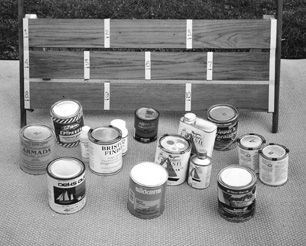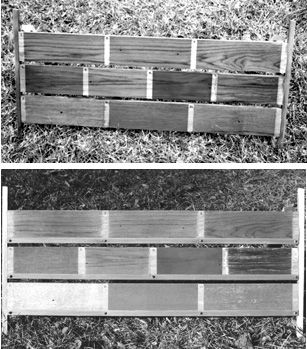
]Almost two years ago, Practical Sailor decided to test varnish vs. teak oils vs. “teak systems” to determine what products best keep teak looking good
This effort was initiated to find a single answer to countless reader inquiries about “what should I do regarding the teak on my boat?”
Yet after years of testing a wide range of products, it was apparent that a single answer wouldn’t do.
Varnish tests are going on at PS most of the time. Teak oils have been tested exhaustively. Synthetic “systems,” often presented by their makers as the “perfect solution,” have also been put through their paces.
Because such tests are long-term projects, no sooner is one completed than it’s time to begin another. That’s because manufacturers are constantly introducing new solutions to this old problem.
The basic overriding truth is that the teak on your boat is never, ever going to look as good as it did when it was new. The elements are working against you. Dirt, stains, and saltwater do some damage, but UV rays from the sun remain 99 percent of the problem. (Some skippers, in a vendetta against suntan oil, have been known to pat down every firsttime crew member.)
The only way to recapture the original beauty of newly-milled teak is to sand off a very thin layer of weathered teak, but how many times do you want to do that? Even though the weathered layer is very, very thin (try it on a piece of scrap), there’s no escaping the fact that you’re removing material, and there’s only so much of that to begin with.
Short of that, what can be done?
After years of testing varnish, teak oil, and “systems,” PS decided to combine the results and undertake a Teak Treatment All-Stars test.
The intent was (1) to evaluate how the products handle in the application; (2) how they look when first applied, and, the most important, (3) subject all of them to exactly the same exposure and see how they fare over time.
From the most recent separate tests, the three best varnishes, the four best “systems” and the three best oils were gathered up for our “best-of-the-best” run-off. (One oil, the widely-known Deks Olje, was included, even through the maker concedes that it’s matte finish variety is good for just one season, or about six months. If a more lasting shiny coat is desired, Deks Olje suggests that you add several coats of the gloss version.)
One of the “systems,” C Tech Marine’s Bristol Finish, had its formulation changed while the PS test was underway. Unfortunately, it was too late to substitute the new formulation.

]That left eight of these products to soldier on. Mind you, all of them had ranked one, two or three in previous separate tests. The three varnishes are Epifanes, Pettit’s Hi-Build, and West Marine’s Skipper. The three synthetics “systems” are Armada MC 2000, Honey Teak, and Smith & Co. 5-Year. (We learned after the test began that Armada discontinued making the MC 2000.) The two oils (or stains) are Sikkens’ Cetol and West Marine’s West Wood Pro.
The products were applied, as directed, to ample-sized segments of well-seasoned teak boards. Small one-inch covering strips were added to the bottom edge of each of the three boards to provide a comparison with the exposed areas.
The rack was placed outdoors in January 2003, positioned (and occasionally re-oriented) to get full perpendicular sunrays, along with wind, rain, snow, blowing dirt, and a few deliberate dashes of saltwater fetched from the harbor.
Our original report, noting all the specifics of the products and the test procedure, was published in the March 2003 issue of Practical Sailor. The rack was often examined as the weeks passed, and in July of that same year it was brought indoors for a closer examination.
The results of that early weathering appeared in a report in the Nov. 15, 2003 issue. At the time, we described all three varnishes as “the best by far,” but the heavily pigmented Honey Teak; and the two pigmented stains—Sikkens’ Cetol and the West WoodPro—were still in the running.
Back went the rack outdoors, for further abuse from Mother Nature.This past December (2004), nearly two years after first being placed outdoors, the rack was brought in for a final evaluation.
Conclusions
On the chart that accompanies this report are observations about the eight products, along with as much information as possible from the similar charts that were published with the initial article in the March 2003 issue and the six-month report in the Nov. 15, 2003 issue. (The earlier charts included information about how many coats are recommended, how soon you can recoat, whether you’re to sand between coats, and how the product handled.)
For the meticulous boat owner who does his own work and is concerned with all facets of teak treatment, PS recommends a review of all three of these reports. The exception would be those who prefer the appearance of weathered teak, which turns a silvery gray in about three years. These owners have only to wait and try to keep the raw teak clean; it’s not easy.
If you want your teak varnished, any one of these three are excellent. In our test, all remained intact, with no breaks in the skin. The Epifanes has the smoothest skin, but appears to have darkened a bit. The Pettit seems to have faded slightly. The West Marine has a thin look to it, perhaps because it is very thin coming out of the can. Because it seems more substantial, the edge goes to Epifanes.
Among the three remaining synthetics, the matte-finish Armada MC 2000 is intact, but lacks the good color that Sikkens’ Cetol has. And the gloss Honey Teak doesn’t seem the equal of Epifanes varnish. (The gloss Smith & Co. 5-Year didn’t do well in the six-month review; it had developed streaks.) Of the two pigmented oils (or stains), the West WoodPro has gone blotchy and discolored, leaving the Sikkens Cetol as the best choice for a matte finish.
After two full New England winters and two summers, this very prolonged PS test sifted out some leaders among previous winners, but it’s still up to you as to whether you want your teak to have a shiny or matte finish.
Also With This Article
“Teak Treatment All-Stars After Two Years”
“Making Do”
Contacts
• Armada, Blue Water Paints, 800/432-4333, www.armadacoatings.com
• Bristol Finish (C Tech Marine), 321/752-7533, www.bristolfinish.com
• Deks Olje, 800/321-3444, www.floodco.com
• Epifanes, 800/269-0961, www.epifanes.com
• Honey Teak, 772/287-6077, www.signaturefinish.com
• Pettit Paint, 800/221-4466, www.pettitpaint.com
• Sikkens Cetol, 011-31 10 5033 54, www.sikkensyachtpaints.com
• Smith & Co., 800/234-0330, www.fiveyearclear.com
• West Marine, 800/262-8464, www.westmarine.com





































